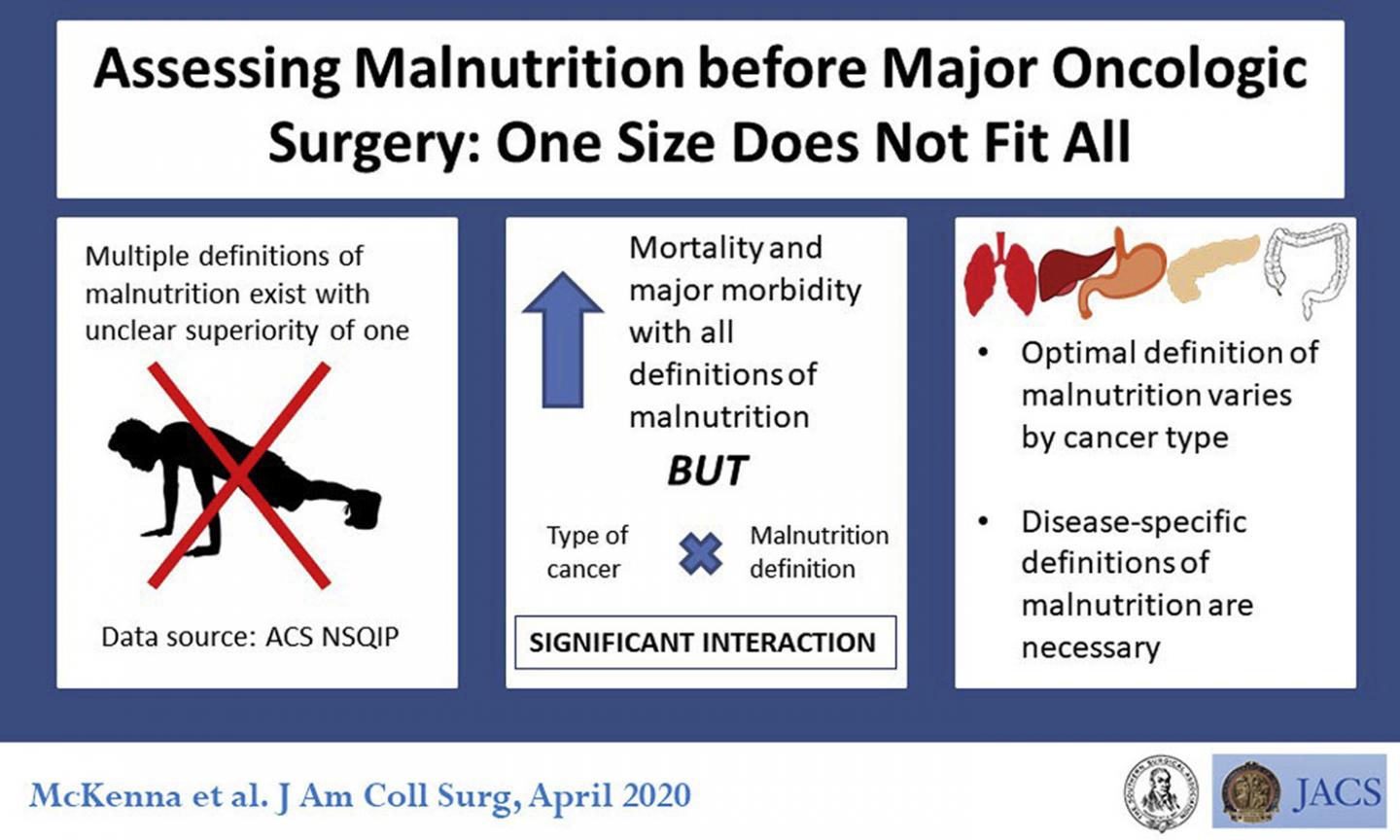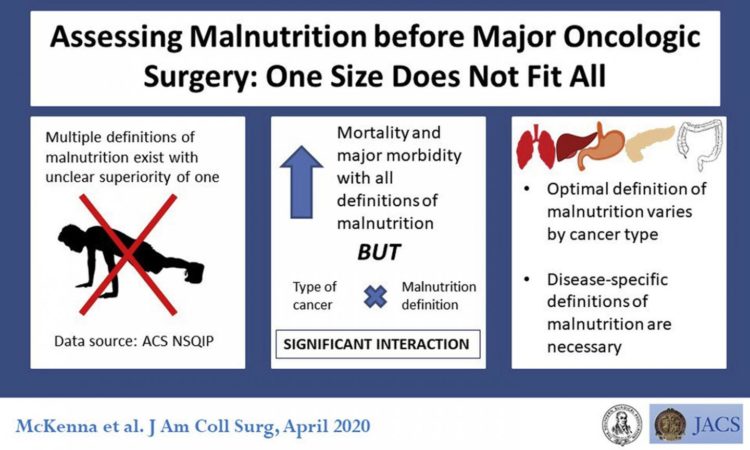Journal of the American College of Surgeons study authors stress the need for proper recognition and treatment of malnourishment in cancer patients before an operation

Credit: American College of Surgeons
CHICAGO (February 26, 2020): The best approach for surgeons to identify malnourished cancer patients before they have a cancer operation may be specifically related to the type of cancer the patient has, according to researchers who found that common definitions of malnutrition do not apply equally to all cancers in assessment of preoperative risk. The study is published as an “article in press” on the Journal of the American College of Surgeons website ahead of print.
Cancer-related malnutrition is common–affecting between 20 and 70 percent of cancer patients1–because of the disease or its treatment. Many studies show that malnutrition raises the risk of complications from a major cancer operation, but patients can improve their nutritional status through preoperative rehabilitation, or “prehabilitation,” programs involving nutrition counseling, nutritional supplementation, and exercise.
“Surgeons must know a patient’s nutritional status to predict outcomes and direct therapy,” said study coauthor Robert Cima, MD, FACS, a general surgeon at Mayo Clinic, Rochester, Minn. “A malnutrition screening tool meant for the general population is not useful in patients with cancer. Their cancer diagnosis already places them at high risk of malnutrition.”
Yet, the common definitions of malnutrition that surgeons use for risk assessment vary widely, and the best definition is unclear, said lead study author Nicholas P. McKenna, MD, a third-year surgical resident at Mayo Clinic. The simplest malnutrition definitions, Dr. McKenna said, rely on unintentional weight loss and/or body mass index (BMI), a measure of body fat based on height and weight.
To determine the best simple definition of malnutrition in cancer patients for preoperative risk assessment, the investigators studied clinical registry data from the American College of Surgeons National Surgical Quality Improvement Program (ACS NSQIP®) database. ACS NSQIP is the leading nationally validated, risk-adjusted, outcomes-based program to measure and improve the quality of surgical care in hospitals. Using ACS NSQIP data, the researchers identified 205,840 major cancer resection (removal) operations performed from 2005 to 2017 for six types of cancer: colorectal, esophageal, gastric, liver, lung, and pancreatic. Using statistical analyses, the research team studied the effect of malnutrition on the risk of any major postoperative complication (a composite including infections, pulmonary problems, stroke, and heart attack) or death within 30 days of the operation.
Malnutrition definitions
The researchers evaluated patients’ nutritional status using several current classifications: the European Society for Clinical Nutrition and Metabolism (ESPEN) diagnostic criteria for malnutrition,2 the ACS NSQIP risk factor of more than 10 percent weight loss over the prior six months, and the World Health Organization (WHO) BMI classification.3
ESPEN defines malnutrition in two ways, according to Dr. McKenna: (1) by age: for patients younger than 70 years, BMI below 20 kilograms per meter squared (kg/m2), or for patients 70 or older, BMI below 22 plus unintended weight loss either greater than 10 percent of body weight over any time or more than 5 percent in the past three months; or (2) a BMI below 18.5 alone, which the WHO considers severely thin. The study authors called these definitions ESPEN 1 and 2.
Using those definitions, the researchers added their own definitions of “severe malnutrition,” a combination of BMI under 18.5 kg/m2 and more than 10 percent weight loss, and “mild malnutrition,” a BMI of 18.5 to 20 for patients younger than 70 or BMI under 22 if age was 70 or above. They called the final malnutrition definition “NSQIP”: more than 10 percent weight loss with a normal BMI (above 20 for ages less than 70 and above 22 for ages 70 and older).
Next, they looked at the risk of major postoperative complications associated with each nutrition category, including obesity and no malnutrition, for all patients and by cancer type.
Implications for surgeons and patients
“We found that using one-size-fits-all definitions of malnutrition across all cancer types when counseling a cancer patient preoperatively could result in overestimating or underestimating the patient’s risk of complications after a major cancer resection procedure,” Dr. McKenna said.
They found that the malnutrition (undernutrition) definition that best predicted postoperative risk differed for six cancer types as follows:
- Colorectal: severe malnutrition
- Esophageal: ESPEN 2
- Gastric: ESPEN 1
- Liver: NSQIP
- Lung: ESPEN 1
- Pancreatic: ESPEN 1
The best malnutrition definition also varied by cancer type for predicting the risk of dying within a month after a cancer operation, the researchers reported.
“Because it is uncommon for surgeons to look at cancer type when estimating malnutrition-related preoperative risk, these results could potentially change surgeons’ view of how to evaluate cancer patients,” Dr. Cima said.
He recommended that surgeons consider, “What is the best marker of nutritional status for this cancer type?”
“Cancer patients should understand that good nutrition before having an operation is very important,” Dr. Cima concluded.
###
Other study coauthors are Katherine A. Bews, John H. Pemberton, MD, FACS, and Elizabeth B. Habermann, PhD, all from Mayo Clinic, Rochester, Minn.; Waddah B. Al-Refaie, MD, FACS, from MedStar Georgetown University Hospital, Washington, D.C.; and Dorin T. Colibaseanu, MD, FACS, from Mayo Clinic, Jacksonville, Fla.
Authors had no disclosures related to this study.
“FACS” designates that a surgeon is a Fellow of the American College of Surgeons.
This study was presented at the Southern Surgical Association 131st Annual Meeting, Hot Springs, VA, December 9, 2019.
Citation: Assessing malnutrition before major oncologic surgery: one size does not fit all. Journal of the American College of Surgeons. DOI: https:/
1 Arends J, Baracos V, Bertz H, et al. ESPEN expert group recommendations for action against cancer-related malnutrition. Clin Nutr. 2017;36(5):1187-1196. DOI:10.1016/j.clnu.2017.06.017
2 Cederholm T, Bosaeus I, Barazzoni R, et al. Diagnostic criteria for malnutrition–an ESPEN consensus statement. Clin Nutr. 2015;34(3):335-340. DOI:10.1016/j.clnu.2015.03.001
3 World Health Organization. BMI classification. Available at: http://apps.
About the American College of Surgeons
The American College of Surgeons is a scientific and educational organization of surgeons that was founded in 1913 to raise the standards of surgical practice and improve the quality of care for surgical patients. The College is dedicated to the ethical and competent practice of surgery. Its achievements have significantly influenced the course of scientific surgery in America and have established it as an important advocate for all surgical patients. The College has more than 82,000 members and is the largest organization of surgeons in the world. For more information, visit http://www.
Media Contact
Sally Garneski
[email protected]
312-202-5409





